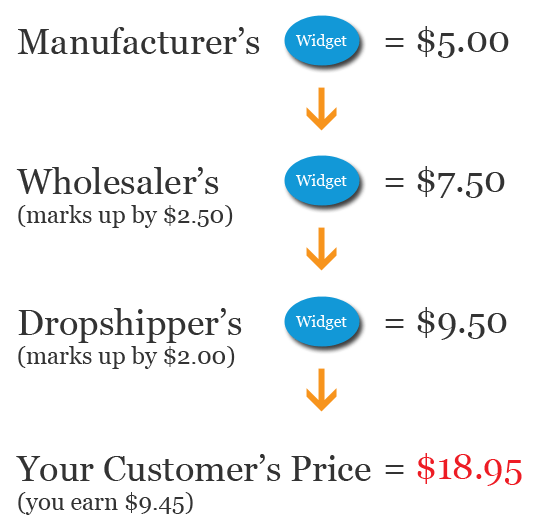10 Questions You MUST Ask Potential Dropshippers
 After you’ve spent time searching for dropshippers, you may find yourself with a long list of potential suppliers, but not much information on which ones fit your particular business model. Many of the dropshippers I work with are actually wholesalers and manufacturers. They don’t advertise their dropshipping program. So, in order to make sure you’ve found the right supplier, you need to ask the right questions. In this article, I’ll tell you what questions you must ask when approaching a potential dropshipper and explain why these questions are so important. Let’s begin.
After you’ve spent time searching for dropshippers, you may find yourself with a long list of potential suppliers, but not much information on which ones fit your particular business model. Many of the dropshippers I work with are actually wholesalers and manufacturers. They don’t advertise their dropshipping program. So, in order to make sure you’ve found the right supplier, you need to ask the right questions. In this article, I’ll tell you what questions you must ask when approaching a potential dropshipper and explain why these questions are so important. Let’s begin.
1. Do you offer a Dropship Program for online stores?
Well, this one’s easy, right? NOT QUITE! There are actually two different meanings for the term “dropship.”
Retail Dropshipping
Retailers offer dropshipping for customers. So, if I wanted to place an order for a birthday present for my Mom, I might want the gift to be shipped directly to her. In this case, the retailer would dropship my order to my Mom. I am not a company and I have not signed up for a dropshipping program with this retailer – this is just a standard service they offer. Their company name is on the packing slip and my Mom is fully aware of the retailer.
Wholesale Dropshipping
If I own an online store and want my customers’ orders shipped directly to them with my company name on the packing slip, I would use a dropship program. In this case, my customer has no idea their order was shipped from a wholesaler/manufacturer. I receive a discount on all merchandise and then markup the products for my customers. This is completely different from standard retail dropshipping.
This is a crucial question to ask for a couple reasons:
- Many retailers actually offer their products for wholesale to businesses. But, if you approach a retailer about a dropshipping program, you need to make sure they understand which form of the term “dropshipping” you’re using. You must make sure the retailer understands what you’re asking.
- Not all wholesalers and manufactures offer dropshipping. They only offer their products for bulk purchases ($1000 minimum order shipped to your business for example). You need to clarify with a wholesaler what your intentions are.
2. Do you ensure my company’s information is on the packing slip/package?
This is what I would call an “over-kill” question. If the dropshipper answers the previous question with a “yes,” then this question may be redundant. But, I still ALWAYS ask it. It simply helps to reiterate my intentions with their company.
Also, rather than your name on the box and packing slip, your dropshipper may put something like “Fulfillment Center” on all orders. This is usually to save them time and money when dealing with a large number of dropship clients. This may not be an issue for you (I’ve worked with dropshippers who do this), but it’s important for you to know exactly how your orders will appear when they’re delivered to your customers.
You will also need to be aware of the contact information they add to the packing slips. I found this out the hard way when some of my customers began calling my cell phone! One of my dropshippers was printing my cell number rather than my toll-free company number on the packing slips. Verify exactly what is printed on each packing slip (company name, address, phone number, contact person)!
3. What is the discount on your products for dropshippers?
Obviously, it’s important to find out your cost of goods sold so you can price your inventory appropriately and ensure you make a profit. But, it’s especially important to inquire about your discount for a dropship program. Here’s why:
Retailer’s Discount
If you choose to work with a retailer who offers dropshipping, it’s crucial they offer a sufficient discount for you. Since your dropshipper in this case is also a retailer, they will be a competitor of yours as well as your supplier. If they only offer you a 15% discount on their products, you’re going to find it extremely difficult to compete. This is one of the major deterrents of working with a retailer. However, if they already price their items extremely low, you may find the 15% discount is all you need. Remember this – working with retailers may force you into a completely different pricing strategy than you had anticipated. You won’t be the low price leader in your industry. So, you will have to focus on making your company stand out in other ways.
Wholesaler’s Discounts
If you choose to work with a wholesaler who offers dropshipping, you’ll most likely find they charge their dropship clients more than their wholesale clients. This makes complete sense as they are not just providing a product, but a service for you – fulfillment. Some wholesalers markup every product by a small percentage for dropshippers. Others simply charge a dropship fee per order (maybe $3-5). This is a standard practice and should NOT deter you from working with them. Just make sure the cost is reasonable.
The prices you charge your customers will be based entirely on your costs. Your USP (Unique Selling Proposition) may rely on your costs as well. Your USP is the special and unique value your company offers to customers. Are you the low cost leader? Do you offer the biggest selection? Do you guarantee same day shipping? These are all examples of USPs. Your costs may affect the USP you had planned on, so take the time to inquire about your costs and ensure they’re aligned with and support your USP.
4. What are your damaged/return policies for dropship orders?
Many dropshippers charge a restocking fee for returns (some up to 25%). So, if you purchase a product for a customer that costs you $100 and the customer decides to return it, you will only receive $75 back from your dropshipper. You just lost $25. This is a standard practice, so you may have to suck this one up. You also want to make sure their guarantee timeline works with yours. If you offer a 30 day return policy, but your dropshipper limits returns to 10 days, you still have to honor your guarantee.
 Here’s a tip to help reduce your return costs – for small orders, have your customer ship the return back to you, not your dropshipper. Keep the item(s) in your office. Now, if you get an order for this item in the future and it happens to be out of stock with your dropshipper, you can ship the one you have! This way, you will lose less money in the return and won’t lose a future order due to the lack of stock! Here’s a tip to help reduce your return costs – for small orders, have your customer ship the return back to you, not your dropshipper. Keep the item(s) in your office. Now, if you get an order for this item in the future and it happens to be out of stock with your dropshipper, you can ship the one you have! This way, you will lose less money in the return and won’t lose a future order due to the lack of stock!
|
It’s also important to make sure your dropshipper replaces damages with minimal effort on your part. One of the WORST dropshippers I’ve ever worked with made damage replacements unbelievably painful. They actually required a picture of the damaged item to be uploaded to their website for them to verify. This is a sign of a low quality dropshipper!
How many of your customers will have the computer knowledge to send you a digital photo of their order? And even if they do, why would you want them to go through the trouble? It’s not their fault their order was damaged! The best dropshippers don’t ask questions. They just replace your customer’s damaged items and DO NOT require the item to be returned. This makes your life easier and leaves a great taste in your customers’ mouths.
5. Do you charge sales tax or require my seller’s permit?
Most legitimate dropshippers will require a copy of your seller’s permit (resale certificate). This helps ensure they are not responsible for charging you sales tax. However, some may not require your permit and simply charge you sales tax if your business exists in the same state as your dropshipper’s. In this case, you will need to keep track of how much sales tax you paid so that you can deduct it from what you owe to your state at the end of the year. Always be prepared to provide your seller’s permit!
6. May I use your products’ images/descriptions on my website?
Since you’re working with products you won’t actually see in person, it’s important your dropshipper offers accurate and detailed information on their products. These details include:
- Product Image
- Description
- Composition – what it’s made of
- Measurements
- Shipping Weight
When you’re first starting out, you may find it easier to copy the descriptions of your products from your dropshipper’s website, but you must obtain their authorization first! Some do not allow this practice as they want their website content to be unique for SEO purposes. Ideally, you should write your own descriptions for the same reason. Also, remember many wholesalers/dropshippers don’t know how to sell to retail customers. So their descriptions may be short and boring. You have to sell your products to your customers through words and pictures. Make your descriptions interesting!
As for pictures, you may run into copyright issues, so always obtain authorization prior to using your dropshipper’s photos. Some dropshippers may provide photos for you on a CD.
7. How do I place my dropship orders (i.e. online/email)?
This is simple – will you be placing your orders online or by email? If online, you need to ensure you have a discount code for your orders or login information. If by email, you need to know exactly who to send your orders to and ensure they respond with a confirmation. Save your receipts/invoices for your records. Also, find out if you are charged immediately or once your orders ship.
 Some ecommerce hosting solutions offer automated dropship notification. For example, Network Solutions’ Pro Ecommerce Package (the only ecommerce hosting I use) allows you to set up dropshippers within your control panel. When an order is placed, an email is automatically sent to your dropshipper with the order information. This can save you a bunch of time, but you need to find out if your dropshipper allows orders by email. Some ecommerce hosting solutions offer automated dropship notification. For example, Network Solutions’ Pro Ecommerce Package (the only ecommerce hosting I use) allows you to set up dropshippers within your control panel. When an order is placed, an email is automatically sent to your dropshipper with the order information. This can save you a bunch of time, but you need to find out if your dropshipper allows orders by email.
|
8. How long does it take for orders to be processed and shipped?
A potential dropshipper once told me their orders would ship in 5 business days. NOT GOOD ENOUGH! I never placed an order with them.
To understand the importance of this question, we need to first understand our customers. When someone shops online, they are doing so for many reasons, but one of the most important is so they can order something right now! They don’t have to get in their car and drive somewhere to buy something. Since the popularity of ecommerce has grown exponentially in recent years, more online stores offer same day shipping or 2 day delivery guarantees. Why? Because not only are online consumers looking to buy something right now, they also want it delivered right now! Don’t make them wait. Remember, your shipping policy has to reflect your dropshipper’s policies. Orders should be shipped within 2-3 business days – NO LATER.
9. What shipping methods do you offer and do you provide tracking numbers?
Again, your shipping policies have to reflect your dropshipper’s policies. You can’t say orders are shipped within 1 business day when your dropshipper ships in 3 business days. You also can’t say you ship FedEx when your dropshipper ships UPS. Find out exactly which carriers your dropshipper uses and ensure you will be provided with a tracking number for every order. Your customers will ask you for a tracking number, believe me.
 Some ecommerce web hosting solutions offer tracking integration with their shopping carts (such as Network Solutions). This means, your customers can log into your website and obtain their tracking numbers. This helps reduce the amount of time you spend on customer service and helps your customer feel more confident that their order is on its way. Some ecommerce web hosting solutions offer tracking integration with their shopping carts (such as Network Solutions). This means, your customers can log into your website and obtain their tracking numbers. This helps reduce the amount of time you spend on customer service and helps your customer feel more confident that their order is on its way.
|
10. Are you the manufacturer of your products?
The reason I put this question last is because the answer may not change your decision to work with a dropshipper. Perhaps the manufacturer doesn’t offer dropshipping so you have to work with a retailer or wholesaler. This is ok as long as you can afford the increased costs. But, it’s still important to know exactly how many middlemen there are in the process of getting orders to your customers. Each time a company handles your merchandise, your costs rise. Even more important, the price you charge your customers increases. Here’s a quick example of what I mean:

Each time a company handles your merchandise, your costs rise.
If you’re working with a retailer or wholesaler, it’s beneficial to find out who they’re getting their products from. You want to find the highest tiered dropshipper available so you can lower your costs. Perhaps the manufacturer is willing to dropship. In this case, for the example above, you would save $4.50 on your product! In other cases, the wholesaler that works with the manufacturer may be the highest tiered dropshipper and your price will be $7.50 per widget.
 Important Tip! NEVER, and I mean NEVER work with a dropshipper whose product source is also a dropshipper! You will end up paying erroneous costs and wasting your money. Again, find the highest tiered dropshipper for your products. Important Tip! NEVER, and I mean NEVER work with a dropshipper whose product source is also a dropshipper! You will end up paying erroneous costs and wasting your money. Again, find the highest tiered dropshipper for your products.
|
Let’s Wrap This Up
Wow, that’s a lot of info! If you read this entire article then you are obviously serious about making a living online! In my next article, we’ll talk about how to approach a dropshipper and ensure they will work with us. Sign up for my newsletter so you don’t miss it!
What Questions Do You Ask Potential Dropshippers? Have Any of These Suggestions Worked for You?
Topic Tags:
dropship programs, dropshippers, ecommerce store, manufacturers, retail dropship, sell products online, wholesalers









 I’m Keller Hawthorne, Founder of FresheVenture.com. Whether you’re new to the world of Internet Marketing or already have your own Internet Business, I’m here to help you make a living online!
I’m Keller Hawthorne, Founder of FresheVenture.com. Whether you’re new to the world of Internet Marketing or already have your own Internet Business, I’m here to help you make a living online! 
 Subscribe to My RSS Feed!
Subscribe to My RSS Feed!